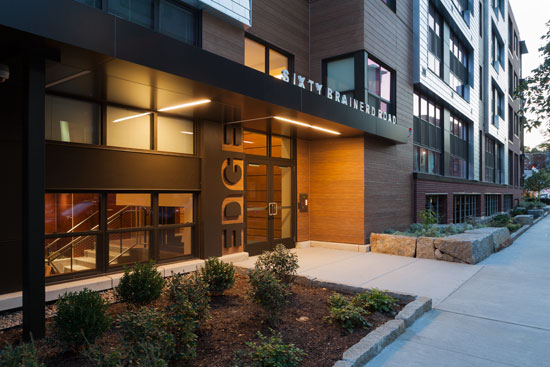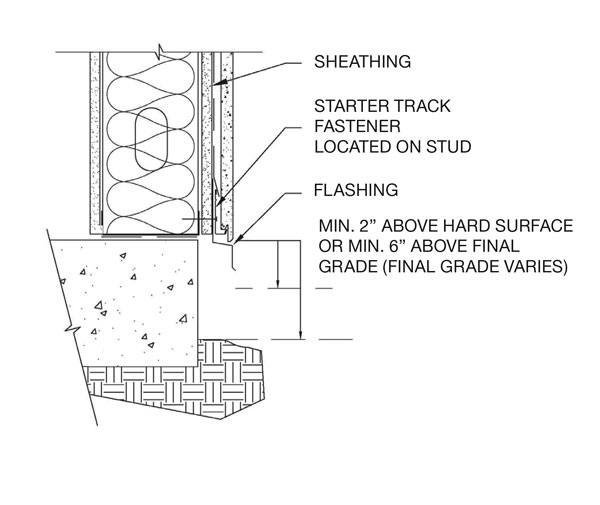Design Innovations Using Fiber Cement in Commercial Construction
Manufacturing Process
Fiber cement products are currently created in a range of types, sizes, and styles. However, in all cases, the fundamental manufacturing process is similar and is based on combining several key ingredients:
▶ Wood fiber sources: Wood chips, raw wood fibers, and other wood products taken from recycled and virgin sources. The organic nature of the wood fibers provides a degree of resiliency and flexibility for the finished products, making them less brittle than some of their historical predecessors.
▶ Portland cement: Acting as the binder to the wood fiber, portland cement works the same way it does in masonry applications by creating a tight, secure bond within the finished product. Typically comprised of limestone, clay, and iron, it brings the inherent strength and rigidity of those elements as well.
▶ Silica filler: An inert filler is often desirable to use in order to reduce weight or contribute other characteristics. In certain fiber cement products, this filler is silica which is essentially just a technical term for sand which is among the most abundant materials on earth. It does not pose any health or environmental concerns unless it becomes airborne which may happen during installation when products might be cut and create dust. In those cases it can be an irritant to eyes and the respiration system while long-term exposure can cause other health concerns.
▶ Alternative fly ash filler: Although it's nearly impossible to eliminate, some fiber cement products contain extremely low levels of silica by using fly ash as an alternative inert filler material. Fly ash is a by-product of burning coal in electric power plants to produce electricity with about 5-10 percent of the coal left behind as fly ash. Since it is an extremely fine, lightweight powder, fly ash is captured in filters before it can escape into the air. According to the American Coal Ash Association, the majority (55 percent) of the 72 million tons of fly ash produced annually is disposed of, typically in landfills, though older plants can use surface ponds, which can create significant disposal issues. In some cases, there have been environmental problems with disposal in facilities not practicing best management techniques. This has caused the U.S. Environmental Protection Agency (EPA) to consider regulating fly ash disposal, to allow for a national guideline rather than the current, non-uniform regulation that occurs at the state level. The remaining 45 percent of fly ash is currently diverted from landfills through beneficial reuse (recycling) in a variety of applications, including fiber cement products. Recycling fly ash currently remains free of regulation, and, in fact, is encouraged by many organizations with different stakeholders. The U.S. EPA, the Natural Resources Defense Council (NRDC), and the U.S. Green Building Council have all agreed that recycling fly ash in building materials and products is beneficial and environmentally desirable. Hence, the EPA and leading environmental groups would like to see this beneficial reuse grow. Fiber cement manufacturers are helping with that beneficial growth while also finding that it improves the overall performance of the end products.
▶ Water: Depending on the manufacturing process, some water may need to be added to the other ingredients to activate the bonding effect. Certain formulations may simply use moisture already present in the other ingredients giving rise to the term “dry system”. Either way, the amount of moisture is measured and controlled to assure that the desired outcome is achieved.
Once the ingredients are proportioned and combined, the resulting material is processed into the desired shape and length. In some cases, stamping processes or molds are used to create the appearance of wood grain, stone, brick, or other patterns. Once the final size is shaped and pattern added, the final step is to apply protective coatings over the fiber cement products. These coatings are either prime coats for field finishing, or factory finish coats for a completely finished panel.
While the fundamental ingredients and processes are the same or similar, there are two distinct categories of fiber cement products—residential and commercial. The two should not be confused since they are fundamentally designed and produced to address different needs, different construction processes, and different aesthetics.
Residential Products
Residential products are essentially an intelligent replacement for traditional wood siding or board products. They are typically applied in a direct nailed manner just like other traditional residential siding products. As such, they require only basic carpentry skills to install without any additional training or special skills. Further, while some fiber cement products are pre-painted, it is more common to find them unfinished ready for standard painting or staining in the field. While this allows for competitive labor prices, it should be noted that the finish warranty is limited to the factory priming or pre-treatment.
From a building enclosure standpoint, residential fiber cement products are durable and often an excellent choice for residential applications. However, keep in mind that they rely on traditional residential water shedding, flashing, and moisture management to create a weathering system for the building. There is no commercial grade moisture management system inherent in these residential products. That means that there is no added cost for materials or specialty labor, but it does mean that careful attention to detail needs to be exercised to achieve a properly constructed assembly.
Commercial Building Products
Commercial fiber cement products are best described as architectural wall panels. They are much more suited to the more rigorous and demanding conditions of commercial buildings, particularly related to wind and weather conditions on multi-story buildings. Recognizing the need for higher performance, manufacturers offer not just the fiber cement panels, but also fully engineered installation systems. Key to the performance of commercial fiber cement products is the proper treatment of the exterior wall underneath including appropriate moisture and air flow management. The installation systems are designed to work with and complement both the integrity of the substrate wall construction and the durability of the architectural wall panels.

Photo courtesy of Nichiha USA, Inc.
Commercial exterior facades that need a strong aesthetic, high performance, and good cost effectiveness all benefit from fiber cement architectural wall panels.
Commercial fiber cement products are commonly fully pre-finished in a range of standard or custom colors and textures with a corresponding warranty on the total finish. For improved appearances, some manufacturers use hidden fasteners to create a clean, uncluttered look desired in many commercial buildings. When these appearance conditions are combined with the engineered installation system, commercial grade fiber cement architectural wall panels become an integral part of a high performance, durable, commercial exterior wall system.
Design Considerations
In choosing to use fiber cement architectural wall panels, there are a number of wall assembly design considerations to take into account. Some of these considerations are common to all assemblies while others will be specific to a particular design approach and solution. Several of these are discussed as follows.
Substrate Design
In all cases, commercial architectural wall panels made of fiber cement are designed to be installed over an appropriately designed exterior substrate. Since the panels and the substrate need to work together to create the weather resistance of the wall system, attention needs to be paid to such things as air barriers, vapor barriers & weather resistive/water resistive barriers. These items are common in many types of wall assemblies and are necessary elements in assemblies using fiber cement architectural wall panels as well. In all cases, a water resistive barrier (WRB) is required when installing fiber cement architectural wall panels. In some cases the WRB may also serve as an air barrier, otherwise that function will need to be addressed with a separate layer. Depending on the climate of the building location, an interior or exterior vapor barrier will also be required. Of course, all openings must have the appropriate flashing to prevent moisture penetration.

Image courtesy of Nichiha USA, Inc.
The design and make up of the wall behind the architectural wall panels needs to address proper air, water, and vapor barrier design using a variety of common building products commercially available.
When designing the make-up of the wall assembly there are a number of choices that can be selected from and considered. Traditional sheet goods or building wraps are common for both residential and commercial construction and rely on paper or fabric materials that are bonded or fused with chemicals or other compounds. In essence, they are installed to seal the entire structure and create a barrier, most commonly for air infiltration control. These sheet goods are stapled or otherwise fastened to exterior sheathing with attention needed to joints and overlapping edges, etc. to create a full and complete barrier, albeit with some compromises made at the fastener penetrations. By contrast, self-adhering sheet goods avoid the need for fasteners. These air and water barriers use multi-laminated layers or fibrous materials bonded together to form a large roll or sheet all backed with an adhesive and easy-release protective film. The sheathing needs to be clean and ready to receive these adhesive backed goods and care needs to be exercised so they are installed cleanly and without unwanted bubbles or other irregularities. The most continuous and seamless form of an air and water resistant barrier is a fluid applied type that is available in spray, trowel and roll on formulations. In this case, all areas are continuously treated, but wall joints can be given appropriate special attention to be well sealed and reinforced at panel joints & sill areas.









